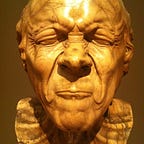Copenhagen’s Rugbrød
Bread making from the best
It was the bread.
Dark, dense, nutty loaves studded with roasted seeds buried into thick, crisp crusts lured me to Copenhagen, a northern European city located directly on the Baltic Sea. Known as “port of the merchants,” this small city, with a population of just over a million souls, is a gourmand’s dream, boasting 13 Michelin-starred restaurants. Further, Copenhagen is one of the most environmentally friendly cities on the planet, with 45% of all food consumed being organic and sourced from a farmer’s field or forest, or hauled out of the surrounding waters.
The city’s steel gray skies, streaked with painterly brushes of white, reflect in the harbor’s dark waters. Anchored schooners, a constant reminder of this Nordic city’s seafaring history, line the canals, barely moving in the still chill. Church spires and rooftops exhibit the pleasingly symmetrical 16th century Dutch Renaissance architecture.
But it wasn’t the buildings I came to behold; it was the bread. I was here to pick the brains of several master bakers; to inquire about ovens, grain mills, flours, and techniques. And of course, to taste their wares, preferably slathered with their famed butter. I had come to be baptized in Danish bread-making traditions.
Historically, wheat was not widely available in the cold European north, fancying instead more temperate climes. Rye, however, has always been easily cultivated and relatively inexpensive. Rugbrød, rye bread in Danish, is a staple of the table; nutritional, low in fat and a great source of fiber. The dough is given an extended fermentation, allowing the hard rye berries to soften. Barley malt is sometimes included in the recipe, but most often the high quality breads consist of only flour and water, the yeasts occurring naturally on the freshly milled husks.
A fine loaf of bread is as much science as art. The tall lanky Danish men with whom I met are passionate, opinionated bakers committed to producing only natural breads. Industrial bread making techniques including the use of yeasts, sugars, and commercial syrups were not part of our discussion, and indeed, inherently eschewed. Lars, a well-humored man with a scruffy beard who was reminiscent of an old Flemish portrait, works with a large, highly regarded food organization. He experiments with different strains of grains, adding various roasted and sprouting seeds to his earthy breads. Brun, a serious man with a wiry athletic build, is re-starting his once heady culinary career. He owns a welcoming bakery in a train station, sourcing Danish grains directly from the farmer and mills them in a handsome wood and ceramic machine in the front of his shop.
Baker’s hours are not banker’s hours. My appointments were early in the morning and the discussions lasted late into the afternoon. I emerged from the bakeries into Copenhagen’s late winter chill, tinged with whole grain flour and overly heated from the constantly stoked ovens. Arms laden with bags of bread, I learned the hard way not to jaywalk here. Mowed down by an executive on a bicycle in a finely cut suit and brimmed fedora, his scarf flying in the breeze, my humiliation was made complete as he loudly berated me in Danish. In this crazy-bike-loving city, 40% of its citizens cycle to work or school on the city’s extensive bike paths. What could I possibly do to mollify the angry hitman on the bike? I proffered him a loaf of my crusty, still-warm bread…
